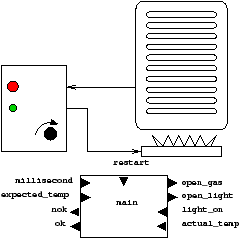 |
| Figure 2.1: The heater |



Consider the problem of a system which control a gas heater as informally depicted in figure 2.1.
Figure 2.1: The heater
The heater front has a green light indicating a normal functioning whereas the red light is turned on when some problem has occurred (security stop). In that case, the heater is stopped and it can be restarted by pushing a restart button. Moreover, a rotating button allows the user to indicate the expected temperature of the water.
The controller has thus the following inputs.
restart is used to restart the heater.
expected_temp is the expected temperature of the water. The heater is
expected to maintain this temperature.
actual_temp is the actual temperature of the water measured by a
sensor.
light_on indicates that the light is on (that is, the gas is burning)
millisecond is a boolean flow given the clock of the system.
The outputs of the controller are the following:
open_light opens the light command.
open_gas opens the valve for the gas.
ok indicate the status of the heater (controlling the green light)
whereas nok indicates a problem (thus controlling the red light).
Only the restart button can restart the heater.
The purpose of the controller is to keep the water temperature close
to the expected temperature. Moreover, when this temperature must be
heated, the controller turns on the gas and light for at most
500 millisecond. When the light is on, only the gas valve is
maintained open. If there is no light after 500 millisecond,
it stops for 100 millisecond and start again. If after three
tests, there is still no light, the heater is blocked on a security
stop. Only pushing the restart button allows to start again the
process.
We start with the definition of a few scalar constants and two auxiliary functions.
let static low = 4 let static high = 4 let static delay_on = 500 (* in miliseconds *) let static delay_off = 100 (* [count d t] returns [true] when [d] occurrences of [t] has been received *) let node count d t = ok where rec ok = cpt = 0 and cpt = d -> if t & not (pre ok) then pre cpt - 1 else pre cpt let node edge x = false -> not (pre x) & x
The following node decides weather the heater must be turn on. We introduce
an hysteresis mechanism to avoid oscillation. low and high are
two threshold. The first version is a purely data-flow one whereas the
second one (which is equivalent) uses the automaton construction.
(* controling the heat *)
(* returns [true] when [expected_temp] does not agree with [actual_temp] *)
let node heat expected_temp actual_temp = ok where
rec ok = if actual_temp <= expected_temp - low then true
else if actual_temp >= expected_temp + high then false
else false -> pre ok
(* the same function using two modes *)
let node heat expected_temp actual_temp = ok where
rec automaton
False ->
do ok = false
unless (actual_temp <= expected_temp - low) then True
| True ->
do ok = true
unless (actual_temp >= expected_temp + high) then False
end
Now, we define a node which turns on the light and gas for 500 millisecond then turn them off for 100 millisecond and restarts.
(* a cyclic two mode automaton with an internal timer *)
(* [open_light = true] and [open_gas = true] for [delay_on millisecond] *)
(* then [open_light = false] and [open_gas = false] for *)
(* [delay_off millisecond] *)
let node command millisecond = (open_light, open_gas) where
rec automaton
Open ->
do open_light = true
and open_gas = true
until (count delay_on millisecond) then Silent
| Silent ->
do open_light = false
and open_gas = false
until (count delay_off millisecond) then Open
end
The program which control the aperture of the light and gas is written below:
(* the main command which control the opening of the light and gas *)
let node light millisecond on_heat on_light = (open_light, open_gas, nok) where
rec automaton
Light_off ->
do nok = false
and open_light = false
and open_gas = false
until on_heat then Try
| Light_on ->
do nok = false
and open_light = false
and open_gas = true
until (not on_heat) then Light_off
| Try ->
do
(open_light, open_gas) = command millisecond
until light_on then Light_on
until (count 3 (edge (not open_light))) then Failure
| Failure ->
do nok = true
and open_light = false
and open_gas = false
done
end
Finally, the main function connects the two parts.
(* the main function *)
let node main millisecond restart expected_temp actual_temp on_light =
(open_light, open_gas, ok, nok) where
rec reset
on_heat = heat expected_temp actual_temp
and
(open_light, open_gas,nok) = light milisecond on_heat on_light
and
ok = not nok
every restart
Supposing that the program is written in a file heater.ls, the
program can be compiled by typing:
% lucyc -s main heater.ls
which produces files heater.ml and main.ml, the later
containing the transition function for the node main.


